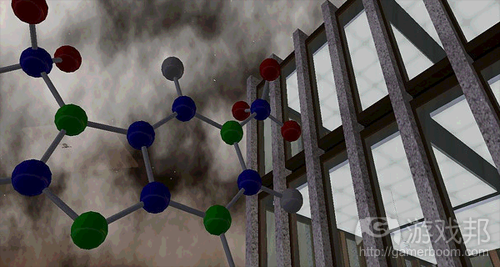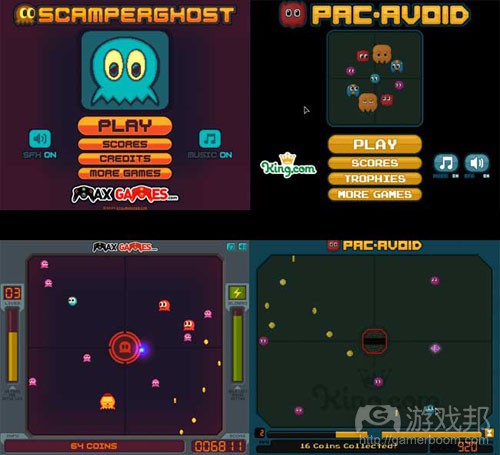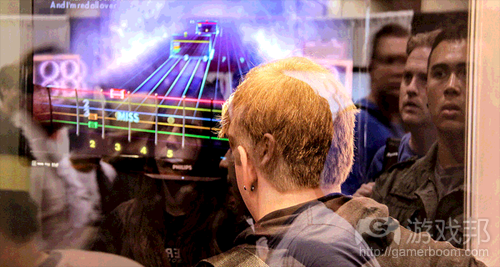游戏公然剽窃与借鉴理念之间的区别
作者:Porter
游戏出现的悠久历史已经足够明确定义游戏题材和机制了。多数新游戏属于这些已知的一种或多种题材,并且由一些机制组合而成。新题材和机制有时也会出现并令世界大吃一惊,但它们实属罕见的例外。如此多游戏使用相同的机制和题材,常让我们觉得游戏看起来都一样,或者玩起来具有相似性——以致于我们有时候会使用“克隆”一词来描述一款游戏,这意味着它是某一现成游戏的相似或准确复制品。但是,究竟什么才算克隆,什么才算是可以接受的借鉴现成游戏或题材的表现?
更小的元素
为了解答这个问题,我们必须首先认清一个简单的事实:每款游戏都可以划分成一个基本元素,或者简单的游戏机制列表。无论我们所指的是原版《行星游戏》还是尚未发布的《光晕5》,这两者都可以划分为更小、更简单的环节。《光晕5》显然更为复杂,并且包含比《行星游戏》更多的元素,但这两者都是由基本游戏机制(只是规模大小有所不同)组合而成的结果。
创造新组合
拆分一款更为复杂的游戏最显著的区别就在于如何拆分。像《行星游戏》这种简单的作品可能不过是一个小小的基本机制组合,可以直接归纳成一个列表。但是更复杂的游戏却拥有需要多次分解的机制。有些机制可能是由多个更小的机制组成,而这些更小的机制则是由更低水平的基础机制所构成。
我们可以在化学中看到这种类似的比喻。在微观层面,水(H2O)是氢(H)的克隆或翻版,因为水是三分之二的复制品,它含有两个氢分子。当然,还也有一点原创性,添加了一个氧分子(O),但这样就真的算是原创吗?
没错。如果没有这个O,我们就无法获得水这种人类所知的最基本化合物了。通过把两样简单的事物,以不同的数量组合在一起,宇宙就能够创造完全独特而令人吃惊的事物。
举例分析
虽然我们现在说的是游戏机制,我们仍然要考虑一款体面游戏的其他关键成份:图像、音频和故事。这三者再结合机制,可以创造更大更独特的特质,例如氛围或情感影响。
这些特质在本文讨论中极为重要,因为它们在行业中还算较新颖的概念。最近有许多游戏几乎专注于氛围或情感影响(游戏邦注:独立游戏领域尤其如此),例如《Slender:The Arrival》或《失忆症:黑暗后裔》。其中多数游戏刚出现时很独特,但却不会太长久。
音乐游戏首次出现在行业中的情况亦是如此。当人们发现一个新模式时,它实际上就转变成了一种新题材,或者主要机制。不久之前行业中还没有那么多音乐游戏,但现在你却可以找到一大把:《热舞革命》、《吉他英雄》、《摇滚乐队》、《狂热节拍》、《摇滚史密斯》等等。那些注重氛围和情感影响的游戏也基本如此,随着开发者不断完美创造这类游戏的方法,我们将在未来数年看到更多类似游戏出现。
例子:《俄罗斯方块》VS《Dr.Mario》
《俄罗斯方块》:
*题材:解谜
*游戏结束机制:方块到达玩法区域顶端时就意味着游戏结束了。
*清除机制:完成一排砖块就清除一排。
*得分机制:清除砖块赢点数,更大的清除操作可以获得更多点数。
*目标:清除一定数量的排数完成关卡,尽量赢取最高得分。
《Dr.Mario》:
*题材:解谜
*游戏结束机制:方块到达玩法区域顶端时就意味着游戏结束了。
*清除机制:集合4个或更多相同颜色的方块,垂直或纵向地消除这些方块。
*得分机制:清除方块赢点数,更大的清除操作可赢得更多点数。
*电影票:通过消除面板上的所有病毒方块完成关卡,尽量赢取最高得分。
我们可以看到,这两者是极为相似的游戏——事实上,任天堂就发现它们的相似性足以捆绑在SNES的同个卡盘上。
通过我们的分析,我们可以看出这些游戏在机制上几乎是相同的,但还是有一些微妙而关键的差别。其核心区别就在于每款游戏消除方块的方式,以及《Dr.Mario》更为明显的关卡进程,这让两款游戏玩法截然不同。虽然没有人可以否认这两款游戏具有相似性,但很显然没有一款游戏是另一者的克隆版本,每一者都有自身的独特创造性。
究竟何为克隆?
现在我们准备回答第一个问题:在游戏开发中,什么是克隆?克隆从定义上讲,就是某物的复制品。在游戏行业中,我们的这一定义没有那么严格,经常指责某款游戏是剽窃或克隆之作。虽然市场上的确存在大量克隆游戏,但事实上,人们的判断还是太草率了,对这一定义也太宽容了。
正如我们之前所述,一个化学元素可以创造一个不同的世界(例如水分子的比喻),游戏开发亦同此理。无论两款游戏有多相似,都要有足够令其创造完全独特体验的特殊元素。这些独特元素可能是在游戏机制、故事或氛围等方面有所不同。目前市场上充斥大量FPS游戏,但有人可以说出任意两款商业FPS游戏是完全相同的吗?几乎每款游戏都会有自己的一些特色,我们很难找到完全没有自身特点的游戏。
而真正的克隆指的是它们的相似性极为明显。克隆通常如此相似,甚至是最微小的细节也完整地复制过来。两位彼此互不相识的开发者可能分别创造出极为相似的游戏,但如果他们真的注入了自己的独特想法,也总会让那些微小细节呈现独特性,并创造出一些原创内容。
这里我们举一个真正的克隆案例,那就是《Pac Avoid》这款最近颇受媒体关注的游戏。《Pac Avoid》明显克隆了《Scamper Ghost》的设计,我之所以如此肯定,是因为我曾在2009年受雇于King.com创造了这款游戏。
这款游戏是真正的克隆典型,因为它现在已经两次被媒体和大众指出来了。第一次是2009年克隆游戏的开发商所提出,第二次是因最近的《Candy Crush Saga》风波所致(游戏邦注:围绕King试图注册“Candy”商标一事)。真正没有争议的克隆产品,极少能够侥幸逃过大众的眼线。
借鉴他人理念
也许这场争议中最复杂的环节就在于,什么时候在其他现成游戏或题材的基础上创造游戏是可以接受的。虽然这可能是人们眼中的最复杂的争议环节,但我还是要说实际上并非如此。
事实上,克隆与非克隆之间还是有个相当明确的界线。我并不认为任何开发者都曾创造一款相似的游戏,并富有法律精神地打量该游戏是否过于接近自己的灵感,但事先却没有一个针对该回答的头绪。自从这一行业诞生以来,游戏之间就彼此依存——这是一个好现象。创造一款高质量游戏的最佳方法之一,就是在原来可行的模型上进行提升。通过向一个已知可行的概念添加一些新机制,你就能创造一些新颖而未精炼的内容。这并不意味着你直接复制一款游戏并优化其物理机制,或者是修复一些漏洞,因为这实际上是一种公然的剽窃行为。
我初次认定自己要成为游戏开发者时,部分原因是我对游戏开发者之前没有实现的目标而感到受挫。我想玩很棒的游戏,脑中充满大量关于如何让游戏更棒的想法,并为那些开发者们为什么没有想到这一点而抓狂。
唯一可行的方法就是看到这些想法变成现实,让我自己成为一名游戏开发者。正如游戏行业的其他人一样,我制作的多数游戏也多是借鉴其他游戏的灵感,只是添加了一些新内容,在原有的理念上进行提升。《Tower of Greed》原先是围绕《Icy Tower》而设计,《Pixel Purge》则围绕《Cell Warfare》和《Geometry Wars》而设计。
鉴于以上想法,我认为极少游戏是纯粹的克隆产品,这类游戏大多能够促进行业的成长。《摇滚乐队》是《吉他英雄》的演化版本,添加了自己乐器,《摇滚史密斯》则创造性地添加了帮助玩家学习一种真正乐器的玩法。《Slender:The Arrival》极为有趣,现在即将面世的恐怖游戏“Daylight”允许《Twitch》用户控制游戏中的一些骇人的机制——它们很可能起源于《Salty Bet》和《Twitch Plays Pokemon》的实时输入机制,但谁能说这种做法不好呢?
第一人称射击游戏问世已经有些年头了,但如果有人重新回头去玩N64个的《Goldeneye》,可能就会觉得它纯粹是垃圾。相似游戏的持续开发是我们当代游戏题材臻于完美的一大贡献力量,也正是那些我们标榜为“克隆”版本的游戏令这一过程成为现实。
总结
总而言之,作为玩家我认为我们必须对克隆的定义更加严格。克隆现象的确不可否认地存在,但对于玩家,或者整个行业的伤害甚小。我们很容易立即判断并指责游戏A克隆了游戏B,但作为个人而言,我们意识到每款游戏自身的独特之处恐怕才是对行业更有利的事情。
历史上极少事物是首次出现的,游戏开发也不例外。这个简单的事实告诉我们,围绕一个现成理念创造内容不但无害,事实上,这还是让今年的成功游戏如此出色的一大要素。(本文为游戏邦/gamerboom.com编译,拒绝任何不保留版权的转载,如需转载请联系:游戏邦)
The Difference Between a Blatant Clone and Building on a Proven Game
by Porter
Games have been around for long enough that clearly defined game genres and mechanics have emerged. Most new games belong to one or more of these genres, and are composed of some combination of these mechanics. New genres and mechanics do occasionally arise and surprise the world, but they are rare exceptions. With so many games using the same mechanics and genres, we often see games that look alike, or play similarly—so much so, that we now sometimes use the term “clone” to describe a game, meaning an exact or near replica of an existing game. But then, what is a clone, and what is considered acceptable building on a proven game or genre?
The Smaller Elements
In order to begin answering this question, we need to first recognize a simple fact: every game can be broken down into a list of basic elements, or simple game mechanics. Whether we’re talking about the original Asteroids, or the unreleased Halo 5, both games can be broken down into much smaller, simpler pieces. Halo 5 will obviously be more complex, and contain more elements than Asteroids, but the end result of either is still a pile (albeit varied in size) of basic game mechanics.
Creating New Compounds
The most noticeable difference when breaking down a more complex game is how it breaks down. A simple game like Asteroids might be no more than a small pile of basic mechanics, which can just be sorted into a list. A more complex game, however, will have mechanics that break down multiple times. Some mechanics will be composed of multiple smaller mechanics, which are in turn composed of a few lowest level base mechanics.
molecule
An analogy to all of this can be found in chemistry. At a microscopic level, one could argue that water (H2O) is a blatant clone or ripoff of hydrogen (H), since water is two-thirds an exact replica, as it contains two hydrogen molecules. Sure, it got a bit original and added an oxygen molecule (the O), but does that really make it original?
Well, in fact, it does. Without that extra O, we wouldn’t have the most essential compound known to mankind: water. By simply taking two simple things, in varying quantities, the universe has created something completely unique and amazing, that in almost no way resembles the unique pieces as far as functionality goes.
Related Posts
The Chemistry of Game Design
The Rest of the Pie
While we’ve now covered game mechanics, we’ve still left out some other key aspects that are essential to any decent game: graphics, audio, and story. All of these, combined with the mechanics, can create some larger, more unique characteristics, such as atmosphere or emotional impact.
These characteristics are extremely important in this discussion, because they feel new to the industry. There are a lot of recent games that focus almost entirely on atmosphere or emotional impact (especially in the indie scene), such as Slender: The Arrival, or Amensia: The Dark Descent. Most of these games are unique at the moment, but they won’t be for long.
What’s happening now is the same thing that happened when rhythm games first hit the industry. A new formula was found (or at least executed so well), that it essentially turned into a new genre, or main mechanic. There weren’t many rhythm games just a little while ago, but now you can find tons: Dance Dance Revolution, Guitar Hero, Rock Band, Beatmania, and Rocksmith, just to name a few. The surge in atmospheric and emotional games is essentially the same thing, and we can all expect many more of them in the coming years as developers perfect their approach to creating these games.
Example: Tetris vs Dr. Mario
Tetris:
Genre: Puzzle
Game Over Mechanic: Pieces reaching the top of the playing field means game over.
Clearing Mechanic: Completing a row of blocks deletes the row.
Scoring Mechanic: Clear pieces for points, larger clears give more points.
Objectives(s): Complete levels by clearing a set number of rows; try to earn the highest score possible.
Dr. Mario:
Genre: Puzzle
Game Over Mechanic: Pieces reaching the top of the playing field means game over.
Clearing Mechanic: Clumping four or greater of the same color pieces horizontally or vertically deletes those blocks.
Scoring Mechanic: Clear pieces for points; larger clears give more points.
Objectives(s): Complete levels by clearing all virus blocks on the board; try to earn the highest score possible.
As we can see, both Tetris and Dr. Mario are very similar games—so similar, in fact, that Nintendo found it suitable to bundle them together on a single cartridge for the SNES.
Judging by our breakdown, the games are almost identical as far as mechanics go, yet there are slight, key differences. The core difference in how pieces are erased in each game, and the more apparent level progression of Dr. Mario, makes each game play very differently. While nobody can deny the two games are similar, it’s clear that neither game is a clone of the other, and that each is its own unique creation.
What Exactly Is a Clone?
We’re now ready to answer our first question: in game development, what is a clone? A clone, by definition, is more or less an exact replica of something else. When it comes to the games industry, we’re a bit less strict on that definition, and like to accuse games left and right of being ripoffs or clones. While there are indeed a lot of clones out there, the truth is, people are far too quick to judge, and are way too lenient with the term.
As we covered earlier, a single element in chemistry can create a world of difference (like in our water analogy); the same goes for game development. No matter how alike two games are, most have unique elements that change them enough to create an entirely unique experience. These unique elements can vary from game mechanics, to story and atmosphere, and everything between. The market is currently flooded with FPS (first person shooter) games, but can anyone really say that any two commercially released FPS games are too alike? Almost every game brings something unique to the table, and those that don’t are easy to spot.
When it comes to actual clones, they’re almost always quite obvious. Clones are usually so similar, that even the tiniest details will be copied over. Two very similar games can be created without either developer knowing of the other, but if it’s truly a unique idea of their own, the small details will inevitably stay unique and create something original.
An example of an actual clone, and one that’s had its fair share of press as of late, would be Pac Avoid. Pac Avoid is a blatant clone of Scamper Ghost. I know this, because I was contracted by King.com to create it back in 2009.
This game is a great example of how a real clone stands out, because it’s been pointed out by the press and public twice now. The first time was by the developer of the clone’s game, back in 2009, and the second more recently with the Candy Crush Saga scandal (over King.com trademarking the word “Candy”). A true, undeniable clone of anything remotely successful never slips through the cracks, and is always spotted.
Building Off of Others
Perhaps the most complicated portion of the debate, is when it is acceptable to build off of another proven game or genre. While it may be perceived as the most complicated portion of the debate, I’m here to say that it’s not.
The truth is, there’s a pretty fine line between what is a clone, and what isn’t. I don’t think any developer has ever created a similar game, and legitimately wondered whether that game was too close to their inspiration or not, without having a pretty good idea of that answer beforehand. Games have been piggybacking off of other games since the birth of the industry—and that’s a good thing. One of the best way to create a quality game, is to improve upon an already working formula. By adding a few new mechanics to an already proven concept, you can create something new, yet refined. This doesn’t mean you should straight up copy a game and improve upon the physics, or fix a few bugs, as that would be blatant thievery.
When I first decided I wanted to be a game developer, it was partially because I got frustrated at what game developers weren’t doing. I would play a great game, be flooded with ideas on how to make the game even better, and go mad wondering how and why the developers hadn’t added them. The only practical way to see those ideas come to life was for me to become a game developer myself. Just like the rest of the game industry, most of the games I’ve made are heavily inspired by other games, and simply add something to the mix to improve upon an already proven idea. Tower of Greed was originally designed around Icy Tower, Pixel Purge around Cell Warfare and Geometry Wars, and so on.
With all the above in mind, I feel that few games are actual clones, and that most of these games help the industry grow. Rock Band was an evolution of Guitar Hero with its added instruments, and Rocksmith adds the genius inclusion of helping the player learn a real instrument. Slender: The Arrival was excellent fun, and now the upcoming horror game “Daylight” is apparently allowing Twitch users to control some of the game’s scare mechanics—likely stemming from the growing Salty Bet and Twitch Plays Pokemon live input mechanic; who can argue that isn’t cool?
First person shooter games have been around for a long time, but if anyone here has gone back and played Goldeneye for the N64 lately, they’ll see that it’s a mess. The continued development of similar games is undeniably responsible for the near-perfection of our current genres, and it’s games that we label with our broad use of “cloning” that have made this possible.
Conclusion
All in all, I think we as players need to be a bit more strict with our definition of what a clone is. Clones do undeniably exist, but few hurt us as players, or the industry as a whole. It may be easy to jump on the bandwagon and accuse Game A of being a clone of Game B, but it’s far more valuable to the industry, and us as individuals, for us to realize how each game is unique in its own right.
Few things in history are ever mastered the first time around, and game development is no exception. It’s this simple fact that should remind us that it’s not only not bad to build off of a proven concept, but that it is, in fact, what makes many of our successful games today so great.(source:gamedevelopment)
上一篇:如何完善你的在线游戏发行策略











































 闽公网安备35020302001549号
闽公网安备35020302001549号